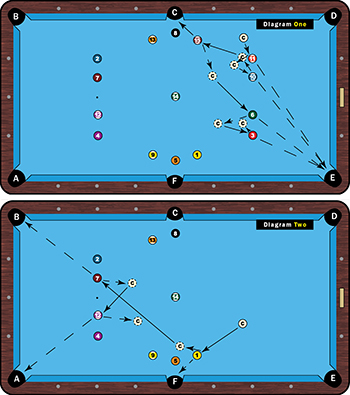A nice 15 ball drill that requires great cue ball control.
This drill has a little bit of everything, so it will improve your success in every game, from rotation games to 8-ball, one-pocket and straight pool. Itís another drill that forces you to think ahead, and when you get down to the last seven or eight balls, you really need to be on point with your cue ball.
I use this drill all the time with my students, and they all love it. It looks easy, but it will have you scratching your head at times. Once you eventually complete the drill, you can be assured your cue ball control and pattern play have improved.
I always talk about cue ball control in tight spaces, and this drill requires that. But you will also learn the importance of cheating the pocket and killing the cue ball.
The rules for this drill are simple: Start with ball in hand and shoot the balls in any order. You can bump another ball and the cue ball canít touch a rail. If the drill is too difficult at the start, allow yourself the option of using a rail if necessary. But even then, try to make as many shots as possible without touching a rail.
There are multiple ways to attack this drill. I suggest leaving the middle balls as long as you can because they are great safety nets if you get out of position on the balls along the middle diamonds. Again, once you get to the last seven or eight balls, you need to start thinking through your run-out pattern, just like in 8-ball and straight pool. I always try to give myself two options when playing those games, and this drill is no different.

Here is the way I approached the drill:
I start with a corner ball first. In this case, itís the 11 ball in pocket E. This is just a little punch shot. Based on the cue ball, I opted to shoot the 10 into the same pocket and use a soft draw to get a nice angle on the 15 into the side pocket C. That angle allows me to draw off the 15 for the 6 in pocket E. Iím hoping to get pretty straight on this shot, and simply draw back for the 3 in pocket E.
Now that youíve eliminated all the balls along the head string, kill the cue ball for the 1 in pocket F. Just roll this ball in with a touch of right to line up with the 7 to pocket B. Playing for this shot is important because now Iím thinking of my pattern. I still have the balls near the side pocket as safety valves in case I lose the cue ball a little. Sometimes itís worth taking a slightly more difficult shot that offers higher reward when you have that safety net.
Use a soft draw on the 7 for the 12 ball, and punch draw from the 12 for the 4 ball. Now you can start connecting the dots. Soft draw on the 4 give you a straight shot on the 14 to pocket D. A stop shot on the 14 will gives you the 2 ball to pocket B, and a soft draw will give you the 13 in pocket C. Punch the cue ball out from there for a simple shot on the 8.

The end is near, with your remaining shots being little more than simple stop shots, first on the 8, followed by the 5 and, finally, the 9 into pocket A.
Making life simple is the name of the game. And if you can control the cue ball and make it your best friend, it will reward you with great success at the table.
I love these types of drills because it teaches you so much about the physics of the cue ball.
Youíll be like Efren in no time!





